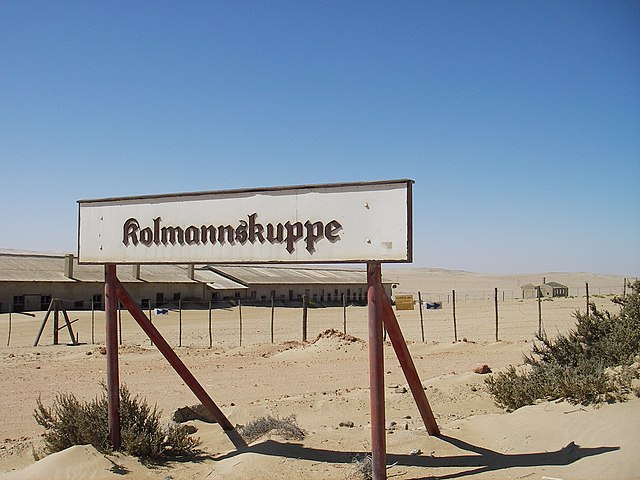Kolmanskop is a ghost town in the Namib in southern Namibia, 10 kilometres (6.2 mi) inland from the port town of Lüderitz. It was named after a transport driver named Johnny Coleman who, during a sand storm, abandoned his ox wagon on a small incline opposite the settlement. Once a small but very rich mining village, it is now a popular tourist destination run by Namdeb, a joint firm owned by the Namibian government and De Beers.
An aerial view of Kolmanskop
An abandoned building
The town sign of Kolmannskuppe
Abandoned houses in Kolmanskop
A ghost town, deserted city, extinct town, or abandoned city is an abandoned settlement, usually one that contains substantial visible remaining buildings and infrastructure such as roads. A town often becomes a ghost town because the economic activity that supported it has failed or ended for any reason. The town may have also declined because of natural or human-caused disasters such as floods, prolonged droughts, extreme heat or extreme cold, government actions, uncontrolled lawlessness, war, pollution, or nuclear and radiation-related accidents and incidents. The term can sometimes refer to cities, towns, and neighborhoods that, though still populated, are significantly less so than in past years; for example, those affected by high levels of unemployment and dereliction.

Plymouth, Montserrat is the only ghost town that is the capital of a modern political territory. It was rendered uninhabitable and evacuated in 1995, after being inundated with volcanic ash from the eruption of the Soufrière Hills Volcano.
As farms industrialize, smaller farms are no longer economically viable, leading to rural decay.
Prior to the Turkish invasion of Cyprus in 1974, Varosha, now falling into ruin, was a modern tourist area.
Akarmara, a mining town in Abkhazia/Georgia, was abandoned in the early 1990s due to the War in Abkhazia.








